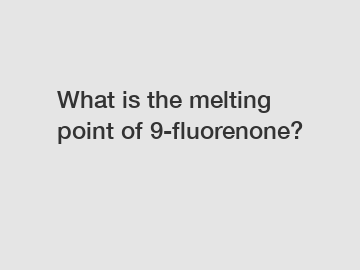What is the melting point of 9-fluorenone?
When it comes to organic compounds, understanding their physical properties is crucial for various scientific applications. One such property that is often of interest to researchers is the melting point of a compound. The melting point is the temperature at which a substance transitions from a solid to a liquid state. Knowing this value can provide valuable insights into the compound's purity and chemical structure.
In this blog, we will explore the melting point of a specific organic compound - 9-fluorenone. 9-fluorenone is a pale yellow crystalline solid that is commonly used in the synthesis of dyes, pharmaceuticals, and other organic compounds. Understanding its melting point can provide valuable information about its purity and potential applications.
The melting point of 9-fluorenone has been widely studied in the scientific literature. The reported value for the melting point of 9-fluorenone ranges from 83-85 degrees Celsius. This relatively narrow range indicates that 9-fluorenone has a well-defined melting point, which is characteristic of a pure compound.

The melting point of a compound is influenced by various factors, including the strength of intermolecular forces, crystal structure, and purity. In the case of 9-fluorenone, the melting point is primarily determined by the interactions between its molecules. 9-fluorenone molecules are held together by weak van der Waals forces, which are relatively easy to overcome when the compound is heated.
The melting point of 9-fluorenone can also be affected by impurities present in the sample. Impurities can disrupt the regular packing of molecules in the crystal lattice, leading to a lower observed melting point. Therefore, when determining the melting point of 9-fluorenone, it is essential to use a pure sample to obtain accurate results.
Measuring the melting point of 9-fluorenone is a relatively straightforward process. A small amount of the compound is placed in a capillary tube, which is then heated gradually while observing the change in physical state. The temperature at which the compound starts to melt and the temperature range over which the melting occurs are recorded as the melting point.
The melting point of 9-fluorenone can also be influenced by the rate of heating. A rapid heating rate may result in a broader melting range, while a slower heating rate can yield a sharper melting point. Therefore, it is essential to control the heating rate carefully when determining the melting point of 9-fluorenone.
In addition to its practical applications, studying the melting point of 9-fluorenone can also provide valuable insights into its chemical structure. By analyzing the changes in physical state during melting, researchers can gain a better understanding of the interactions between 9-fluorenone molecules and the forces that hold them together.
Overall, the melting point of 9-fluorenone is an important physical property that can provide valuable information about this organic compound. By understanding the factors that influence its melting point, researchers can better characterize 9-fluorenone and optimize its use in various applications.
In conclusion, the melting point of 9-fluorenone is an essential property that can be used to assess the purity and structure of this organic compound. By studying its melting behavior, researchers can gain valuable insights into the interactions between 9-fluorenone molecules and the forces that hold them together. The reported melting point of 9-fluorenone is around 83-85 degrees Celsius, indicating a well-defined melting temperature. With further research and analysis, we can continue to expand our understanding of 9-fluorenone and its potential applications in organic chemistry.
If you are looking for more details, kindly visit ni(dppf)cl2, 9-fluorenone density, oled materials.



Comments
0